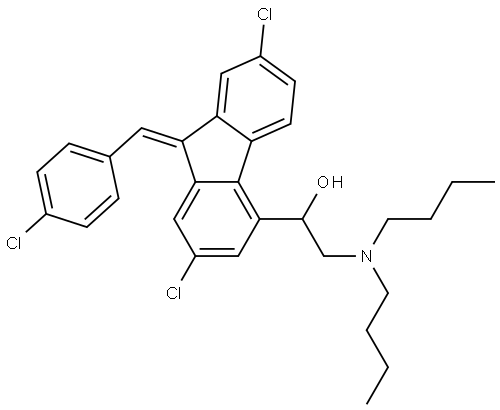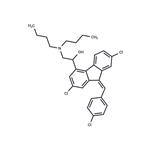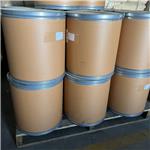Antimalarial drug
Benflumetol and artemether are the widely used antimalarial drugs currently in clinical , they are the main ingredients of the well-known anti-malarial drugs called Compound artemether of Novartis ,which can kill plasmodia asexual, insecticidal rate is high, the cure rate is about 95%, but it is invalid in the pre-erythrocytic stage and gametophyte . Animal experiments suggest it is drug with micro toxicity,but the mutagenic and teratogenic tests are negative. It is mainly used for the treatment of falciparum malaria in clinical, especially for the chloroquine-resistant falciparum malaria treatment.
Physical and Chemical Properties
Yellow crystalline powder, bitter almond smell, tasteless. Soluble in chloroform, slightly soluble in acetone, almost insoluble in alcohol, melting point of 125~131 ℃.
Pharmacokinetics
Oral absorption is slow, elimination is also slow,it can stay a long time in the body . Tmax after administration is 4~5h, t1/2 is 24~72h.
Dosage
4d therapy: Adults eat 800mg at draught on the first day ,on day 2, 3, 4, each 400mg at draught; children daily take 8mg/kg at draught, and continue for 4d, the first dose is doubled, but the first dose does not exceed the maximum dose of 0.6g.
The above information is edited by the chemicalbook of Tian Ye.
Adverse reactions
There are no significant adverse reactions, a small number of patients suffer with electrocardiographic Q~T interval transient mild extending.
Precautions
Patients with heart, kidney dysfunction,should use with caution. After symptoms are controlled in patients with malignant malaria and the parasite is killed in the pre-erythrocytic stage ,primaquine can be used to kill gametocytes. It is saved in the dark, sealed, cool and dry place.
Description
Lumefantrine is a derivative of halofantrine that has been reported to exhibit antimalarial
activity when combined with artemether in the treatment of multidrug-resistant Plasmodium
falciparium . No evidence of cardiotoxicity has been reported with this combination, which
may offer promise for successful treatment of resistant organisms.
Description
Lumefantrine is an antimalarial drug that is used in combination with artemether . The pairing of lumefantrine and artemether is a major form of oral artemisinin combination therapy used against uncomplicated
P. falciparum malaria. Lumefantrine also blocks the rapidly activating delayed-rectifier potassium channel (I
Kr; IC
50 = 8.1 μM).
Chemical Properties
Yellow Solid
Uses
Lumefantrine has been used:
to study its effect on
ex-vivo?Plasmodium falciparum?sensitivity using the tritiated hypoxanthine-based assay
as a standard in the quantification of combined tablet formulation using HPTLC
as a drug molecule in
in vitro growth inhibition assay for
in vitro B. caballi?growth inhibition studies
Uses
Inhibits hemozoin formation. Antimalarial.
Uses
A drug used in the treatment of malaria. Antimalarials are usually classified on the basis of their action against Plasmodia at different stages in their life cycle in the human.
Definition
ChEBI: Lumefantrine is an antimalarial drug used in combination with artemether for the treatment of multi-drug resistant strains of falciparum malaria.
Antimicrobial activity
Lumefantrine has marked blood schizonticidal activity against a wide range of plasmodia, including chloroquineresistant P. falciparum. The 50% and 90% effective concentrations (EC
50 and EC
90) in vitro are similar: <10 and 40 nmol/L, respectively. The racemate and the two enantiomers exhibit similar activities. Blood schizonticidal activity of desbutylbenflumetol is four to five times greater than benflumetol in vitro.
Acquired resistance
Treatment with artemether–lumefantrine can select for polymorphisms
in the P. falciparum pfmdr1 gene. Resistance has
been selected experimentally in murine malaria.
General Description
Lumefantrine was developed in China. Itsmechanism of action is poorly understood. There is some evidencethat it inhibits the formation of β-hematin by forming acomplex with hemin. Lumefantrine is very lipophilic and is marketed in combination with the lipophilic artemesininderivedartemether.
Pharmaceutical Applications
A dichlorobenzylidene derivative given orally in combination
with artemether.
Biochem/physiol Actions
Lumefantrine is is an antimalarial for the treatment of multi-drug resistant strains of falciparum malaria.
Pharmacokinetics
Bioavailability after oral administration is variable; absorption
is substantially increased by co-administration with food,
particularly
with a high fat content. Peak plasma concentrations
occur after 6–8 h. The elimination half-life is 4–6 days. It
is almost completely protein bound and metabolized mainly
in the liver by CYP3A4.
Clinical Use
Treatment of P. falciparum infections (including mixed infections)
in a fixed-dose combination treatment with artemether.
Side effects
The most common adverse effects in combination with artemether
include headache, dizziness and gastrointestinal disturbances.
Metabolism
Primaquine is almost totally metabolized by CYP3A4 (99%), with the primary metabolite being
carboxyprimaquine. Trace amounts of N-acetylprimaquine plus aromatic
hydroxylation and conjugation metabolites also have been reported.




